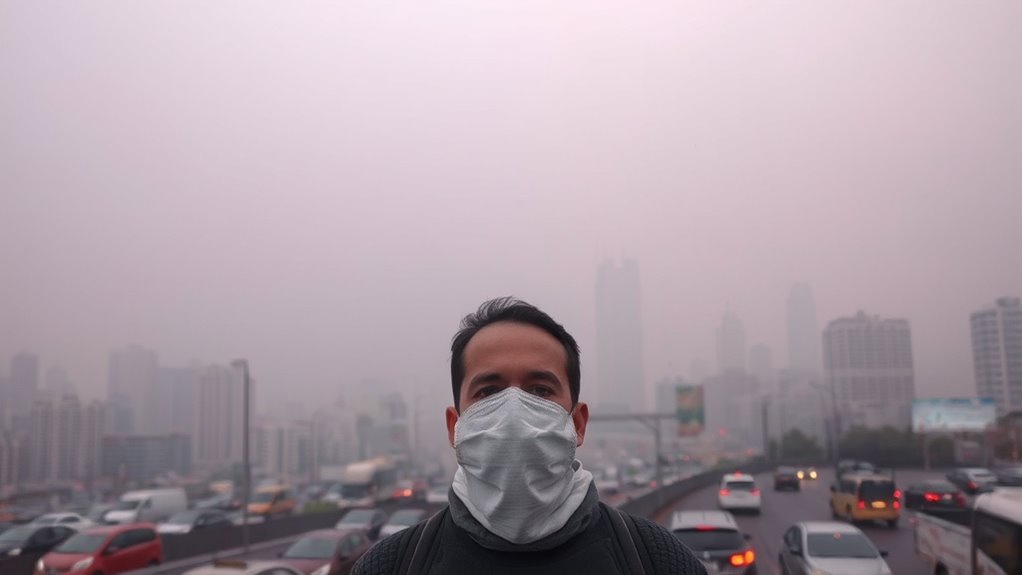Indoor air pollution can considerably affect your respiratory health, as exposure to dust, mold, VOCs, and other household irritants can worsen existing conditions or cause new breathing problems. Poor ventilation and certain activities like cooking or cleaning can increase these dangers. Keeping your home clean, well-ventilated, and free of pollutants helps protect your lungs. To better understand how these risks impact you and how to reduce them, explore the strategies that follow.
Key Takeaways
- Air pollution, including indoor pollutants, can cause or worsen respiratory conditions like asthma and COPD.
- Exposure to pollutants such as dust, VOCs, and tobacco smoke increases the risk of respiratory infections.
- Poor indoor air quality can sometimes surpass outdoor pollution levels, affecting respiratory health indoors.
- Proper ventilation, air filtration, and reduced pollutant sources help lower respiratory health risks.
- Maintaining optimal humidity and avoiding indoor smoking are essential strategies to protect respiratory health from pollution.

Air pollution poses a significant threat to respiratory health, affecting millions worldwide. While outdoor pollution often gets the most attention, your indoor air quality is equally important in safeguarding your lungs. Poor indoor air can harbor pollutants like dust, mold, pet dander, and volatile organic compounds, all of which can aggravate existing respiratory conditions or even trigger new issues. By paying attention to indoor air quality, you take a crucial step in respiratory disease prevention, creating a healthier environment for yourself and your loved ones.
Indoor air quality is vital for respiratory health and disease prevention.
You might not realize it, but the air inside your home can sometimes be more polluted than outside. Common household activities, such as cooking, cleaning, or using certain furniture and paints, release harmful particles into the air. These pollutants can cause irritation in your airways, leading to coughing, wheezing, or shortness of breath. If you or someone in your household has asthma or allergies, maintaining good indoor air quality becomes even more essential. Ensuring proper ventilation and reducing sources of indoor pollution help minimize exposure to these irritants.
To improve indoor air quality, start by regularly airing out your living space. Opening windows when weather permits allows fresh air to circulate and dilute indoor pollutants. Using exhaust fans in kitchens and bathrooms also helps remove airborne contaminants. Additionally, investing in high-efficiency particulate air (HEPA) filters can trap harmful particles, reducing your overall exposure. Keep your home clean, dust-free, and free of mold, as these are common triggers for respiratory problems. Using natural cleaning products avoids introducing unnecessary chemicals that can degrade indoor air quality.
Controlling indoor humidity levels is another key aspect of respiratory disease prevention. Too much humidity fosters mold growth, which can cause respiratory issues, especially for sensitive individuals. Using dehumidifiers or air conditioners helps keep humidity in check, protecting your lungs from mold spores and other airborne irritants. Also, avoid smoking indoors, as tobacco smoke is a potent indoor pollutant linked to respiratory infections, chronic bronchitis, and lung cancer. Additionally, understanding how personal behaviors influence indoor air quality can empower you to make healthier choices for your respiratory health.
Your habits and choices directly impact your indoor air quality and, consequently, your respiratory health. Regularly changing air filters, minimizing the use of scented candles or air fresheners, and keeping your living space tidy all contribute to a healthier environment. By taking these steps, you’re actively reducing exposure to indoor pollutants and strengthening your lungs’ defenses. Understanding the importance of indoor air quality isn’t just about comfort; it’s a essential part of respiratory disease prevention. Taking control of your indoor environment helps you breathe easier and lowers your risk of developing or worsening respiratory conditions over time.
Frequently Asked Questions
How Does Indoor Air Pollution Affect Respiratory Health?
Indoor air pollution can profoundly impact your respiratory health by exposing you to indoor allergens like dust, mold, and pet dander. Poor ventilation strategies trap these pollutants, making you more likely to develop asthma, allergies, or respiratory infections. To protect yourself, improve ventilation by opening windows, using air purifiers, and maintaining cleanliness. These steps help reduce indoor allergens, ensuring cleaner air and healthier lungs.
Can Air Purifiers Reduce the Risk of Respiratory Issues?
Did you know that using air purifiers with HEPA filters can cut airborne particles by up to 99.97%? Yes, they can substantially reduce the risk of respiratory issues by improving air quality in your home. HEPA filters trap pollutants, allergens, and bacteria, creating a cleaner environment. So, investing in an air purifier helps you breathe easier and protects your respiratory health, especially if you live in urban areas or have allergies.
What Are the Long-Term Effects of Air Pollution Exposure?
Long-term air pollution exposure can cause chronic lung damage and increase your respiratory susceptibility. Over time, you might experience persistent coughing, wheezing, or even develop conditions like asthma or chronic bronchitis. Your lung function may decline, making you more prone to infections and breathing difficulties. Protect yourself by reducing exposure, using air purifiers, and avoiding polluted environments whenever possible to minimize these long-term health risks.
Are Children More Vulnerable to Air Pollution-Related Respiratory Problems?
Think of children’s lungs as delicate sponges still soaking up their environment; they’re indeed more vulnerable to air pollution-related respiratory problems. Pediatric susceptibility is higher because their developing lungs and immune systems face greater challenges from pollutants. You might notice that kids often wheeze or cough more during smoggy days, highlighting their developmental vulnerabilities. Protecting their health means minimizing exposure, especially during high pollution periods, for their long-term well-being.
How Does Weather Influence Air Pollution Levels and Health Risks?
Weather considerably influences air pollution levels through seasonal variations and meteorological impacts. When it’s hot or still, pollutants tend to accumulate, increasing health risks. Conversely, rain and wind can clear pollutants from the air, reducing danger. You should pay attention to weather forecasts, especially during seasons with high pollution, to protect your respiratory health. Being aware of these meteorological impacts helps you minimize exposure and stay healthier.
Conclusion
You now understand how air pollution directly impacts your respiratory health. Did you know that exposure to polluted air increases your risk of respiratory diseases by up to 30%? That’s a significant number, highlighting the importance of staying informed and taking action. By reducing exposure and advocating for cleaner air, you can protect your lungs and improve your overall health. Remember, even small steps can make a big difference in breathing easier every day.









